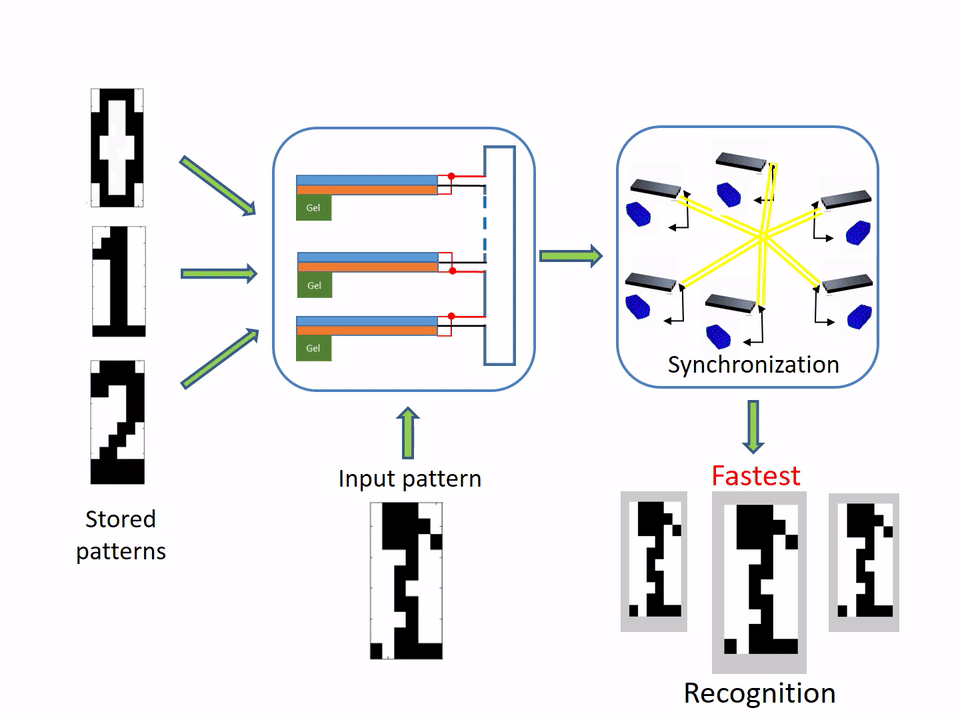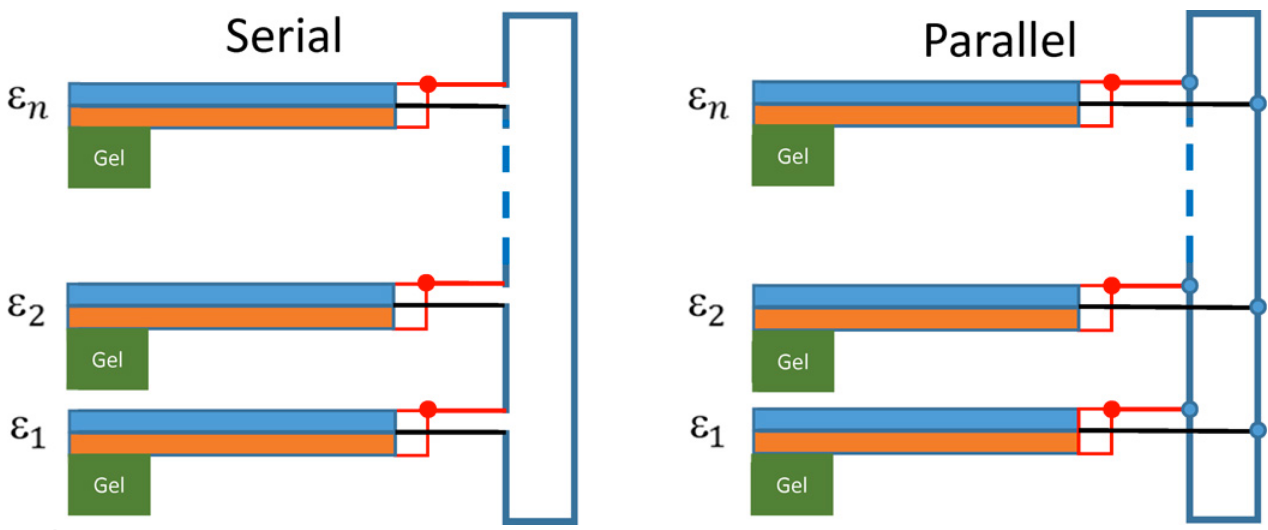Self-powered ‘materials that compute’ and recognize simple patterns
September 20, 2016

Conceptual illustration of pattern recognition process performed by hybrid gel-piezoelectric oscillator system (credit: Yan Fang)
University of Pittsburgh researchers have modeled the design of a “material that computes” — a hybrid material, powered only by its own chemical reactions, that can recognize simple patterns.
The material could one day be integrated into clothing and used to monitor the human body, or developed as a skin for “squishy” robots, for example, according to the researchers, writing in the open-access AAAS journal Science Advances.
A computer that combines gels and piezeoelectric materials
The computations (needed to design the hypothetical material) were modeled utilizing Belousov-Zhabotinsky (BZ) gels, a substance that oscillates in the absence of external stimuli, combined with an overlaying piezoelectric (PZ) cantilever, forming “BZ-PZ” (as in “easy peasy”). The BZ gels oscillate periodically, triggered by chemical stimulation, without the need for external driving stimuli. Piezoelectric (PZ) materials generate a voltage when deformed and, conversely, undergo deformation in the presence of an applied voltage.

Two BZ-PZ oscillator units connected with electrical wires. Triggered by the chemical oscillations, the BZ gels (green) expand in volume, generating a force (F1 and F2) and thereby cause the deflections ξ1 and ξ2 of the PZ cantilevers (orange and blue layers) , which generate an electric voltage U. That voltage then deflects the cantilevers (the inverse PZ effect), which then compress the underlying BZ gels and thereby modify the chemomechanical oscillations in these gels. The end result is the components’ response to self-generated signals (sensing), volumetric changes in the gel (actuation), and the passage of signals between the units (communication). For computation, the communication also leads to synchronization of the BZ gel oscillators. (credit: Yan Fang et al./Science Advances)
“By combining these attributes into a ‘BZ-PZ’ unit and then connecting the units by electrical wires, we designed a device that senses, actuates, and communicates without an external electrical power source,” the researchers explain in the paper.*
The result is that the device can also be used to perform computation. To use that for pattern recognition, the researchers first stored a pattern of numbers as a set of polarities in the BZ-PZ units, and the input patterns were coded with the initial phase of the oscillations imposed on these units.

Multiple BZ-PS units wired in serial and parallel configurations to form a network (credit: Yan Fang et al./Science Advances)
With multiple BZ-PZ units, the oscillators can be wired into a network formed, for example, from units that are connected in parallel or in series. The resulting transduction between chemomechanical and electrical energy creates signals that quickly propagate and thus permits remote coupled oscillators to communicate and synchronize. This synchronization behavior in BZ-PZ network can be used for oscillator-based computing.
The computational modeling revealed that the input pattern closest to the stored pattern exhibits the fastest convergence time to the stable synchronization behavior, and is the most effective at recognizing patterns. In this study, the materials were programmed to recognize black-and-white pixels in the shape of numbers that had been distorted.
The researchers’ next goal is to expand from analyzing black-and-white pixels to grayscale and more complicated images and shapes, as well as to enhance the devices storage capability.
Perfect for monitoring human and robot bodies
Compared to a traditional computer, these computations are slow and take minutes. “Individual events are slow because the period of the BZ oscillations is slow,” said Victor V. Yashin, Research Assistant Professor of Chemical and Petroleum Engineering. “However, there are some tasks that need a longer analysis, and are more natural in function. That’s why this type of system is perfect to monitor environments like the human body.”
For example, Dr. Yashin said that patients recovering from a hand injury could wear a glove that monitors movement, and can inform doctors whether the hand is healing properly or if the patient has improved mobility. Another use would be to monitor individuals at risk for early onset Alzheimer’s, by wearing footwear that would analyze gait and compare results against normal movements, or a garment that monitors cardiovascular activity for people at risk of heart disease or stroke.
Since the devices convert chemical reactions to electrical energy, there would be no need for external electrical power. This would also be ideal for a robot or other device that could utilize the material as a sensory skin.
The research is funded by a five-year National Science Foundation Integrated NSF Support Promoting Interdisciplinary Research and Education (INSPIRE) grant, which focuses on complex and pressing scientific problems that lie at the intersection of traditional disciplines.
“This work at the University of Pittsburgh … is an example of this groundbreaking shift away from traditional silicon CMOS-based digital computing to a non-von Neumann machine in a polymer substrate, with remarkable low power consumption,” said Sankar Basu, NSF program director.
* This continues the research of Anna C. Balazs, Distinguished Professor of Chemical and Petroleum Engineering, and Steven P. Levitan, the John A. Jurenko Professor of Electrical and Computer Engineering.
Abstract of Pattern recognition with “materials that compute”
Driven by advances in materials and computer science, researchers are attempting to design systems where the computer and material are one and the same entity. Using theoretical and computational modeling, we design a hybrid material system that can autonomously transduce chemical, mechanical, and electrical energy to perform a computational task in a self-organized manner, without the need for external electrical power sources. Each unit in this system integrates a self-oscillating gel, which undergoes the Belousov-Zhabotinsky (BZ) reaction, with an overlaying piezoelectric (PZ) cantilever. The chemomechanical oscillations of the BZ gels deflect the PZ layer, which consequently generates a voltage across the material. When these BZ-PZ units are connected in series by electrical wires, the oscillations of these units become synchronized across the network, where the mode of synchronization depends on the polarity of the PZ. We show that the network of coupled, synchronizing BZ-PZ oscillators can perform pattern recognition. The “stored” patterns are set of polarities of the individual BZ-PZ units, and the “input” patterns are coded through the initial phase of the oscillations imposed on these units. The results of the modeling show that the input pattern closest to the stored pattern exhibits the fastest convergence time to stable synchronization behavior. In this way, networks of coupled BZ-PZ oscillators achieve pattern recognition. Further, we show that the convergence time to stable synchronization provides a robust measure of the degree of match between the input and stored patterns. Through these studies, we establish experimentally realizable design rules for creating “materials that compute.”